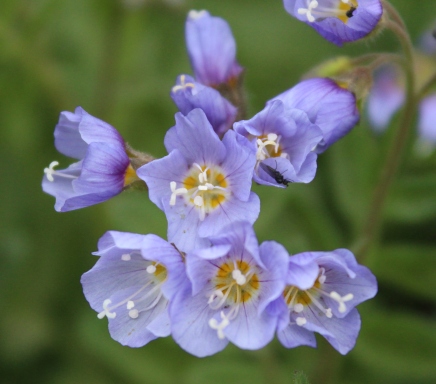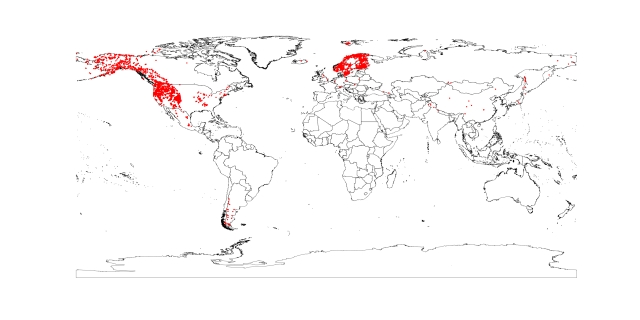Polemonium is a genus of 25 or more species native to North America, Eurasia, and South America. The uncertainty in the number of species is due to several factors including delimitation of species based solely on the pubescence of vegetative characters. Much of taxonomic uncertainty surrounds the widespread Eurasian P. caeruleum species complex. Only the most recently described and/or most distinctive named entities in this complex are listed below.
Polemonium is best recognized by the following combination of characters: perennial habit (except one annual species), alternate, pinnately compound leaves, and a herbaceous calyx without a hyaline connective membrane (in most species).
Phylogeny
Polemonium is sister to a clade comprised of Gymnosteris, Leptosiphon, Linanthus, Microsteris, and Phlox. Within Polemonium, relationships are obscure.
Biogeography
Polemonium is more widespread in Asia than the map indicates.
Taxonomy (^ denotes taxa in the P. caeruleum species complex; # denotes fully or partially Eurasian taxa; * denotes partially South American taxa)
- Polemonium acutiflorum Willd.#^
- Polemonium boreale Adams#
- Polemonium brandegeei (A. Gray) Greene
- Polemonium caeruleum L.#^
- Polemonium californicum Eastw.
- Polemonium carneum A. Gray
- Polemonium caucasicum N. Busch#^
- Polemonium chartaceum H. Mason
- Polemonium chinense (Brand) Brand#^
- Polemonium confertum A. Gray
- Polemonium delicatum Rydb.
- Polemonium eddyense Stubbs
- Polemonium elegans Greene
- Polemonium elusum J.J. Irwin & R.L. Hartm.
- Polemonium eximium Greene
- Polemonium foliosissimum A. Gray
- P. foliosissimum A. Gray var. alpinum (Brand) Anway
- P. foliosissimum A. Gray var. flavum (Greene) Anway
- P. foliosissimum A. Gray var. foliosissimum
- P. foliosissimum A. Gray var. molle (Greene) Anway
- Polemonium glabrum J.F. Davidson
- Polemonium grandiflorum Benth.
- Polemonium higganicum (P.H. Huang & S.Y. Li) S.Y. Li & K.T. Adair#
- Polemonium liniflorum V. Vassil.#^
- Polemonium majus Tolm.#
- Polemonium melindae J. Rzedowski, G. Calderon de Rzedowski & J. Villarreal
- Polemonium mexicanum Cerv. ex Lag.
- Polemonium micranthum Benth.*
- Polemonium nevadense Wherry
- Polemonium occidentale Greene^
- P. occidentale Greene subsp. occidentale
- P. occidentale Greene subsp. lacustre Wherry
- Polemonium pauciflorum S. Wats.
- P. pauciflorum S. Wats. subsp. hinckleyi (Standl.) Wherry
- P. pauciflorum S. Wats. subsp. pauciflorum
- P. pauciflorum S. Wats. subsp. stenocalyx (Standl.) Wherry
- Polemonium pacificum V. Vassil.#^
- Polemonium pectinatum Greene
- Polemonium pseudopulchellum V. Vassil.#
- Polemonium pulchellum Bunge#
- Polemonium pulcherrimum Hook.
- P. pulcherrimum Hook. subsp. lindeyi (Wherry) V.E. Grant
- P. pulcherrimum Hook. var. pilosum (Greenm.) Brand
- P. pulcherrimum Hook. subsp. pulcherrimum
- P. pulcherrimum Hook. var. shastense (Eastw.) Stubbs
- Polemonium reptans L.
- P. reptans L. subsp. reptans
- P. reptans L. subsp. villosum E.L. Braun
- Polemonium sumushanense Lu & Ma#^
- Polemonium vanbruntiae Britt.^
- Polemonium villosissimum (Hulten) D.F. Murray & Elven
- Polemonium viscosum Nutt.
KEY TO POLEMONIUM (modified from Davidson 1950; Grant 1989)
Note: the treatment of Eurasian species here is limited due to uncertainty about the taxonomic validity of these entities.
1. Leaflets so deeply lobed as to appear verticillate
2. Stamens decidedly exserted from the corolla tube
3. Leaflets ovate; not glandular-pubescent
4. Flowers bluish; calyx herbaceous; Humboldt Co. NV…P. nevadense
4′. Flowers whitish; calyx with hyaline membrane; Lemhi Co. ID...P. elusum
3′. Leaflets rounded; conspicuous glandular-pubescent
5. Calyx lobes rounded…P. eddyense
5′. Calyx lobes acute…P. chartaceum
2′. Stamens included in the corolla tube or shortly exsert
6. Corolla 21-31 mm long, consistently white…P. brandegeei
6′. Corolla 8-28 mm long; usually blue (occasionally white)
7. Inflorescence densely glomerulate; throat 10-15 mm wide…P. confertum
7′. Inflorescence loosely compact to elongate; throat 5-10 mm wide
8. Anthers orange; calyx lobes acuminate; widespread Cordilleran…P. viscosum
8′. Anthers white; calyx lobes not acuminate; Sierra Nevada…P. eximium
1′. Leaves coplanar (sometimes densely packed but never appearing whorled)
9. Plants diminutive annuals; calyx shorter than to slightly exceeding the corolla; corolla white; branching sympodial…P. micranthum
9′. Plants well-developed perennials; calyx shorter than corolla; corolla pink to blue; branching not sympodial
10. Corolla lobes exceeding or equal to tube
11. Plants with cauline leaves similar in size to basal leaves
12. Corolla > 25 mm borad
13. Leaflets > 10 mm wide; Pacific Northwest…P. carneum
13′. Leaflets < 6 mm wide; Mexico…P. grandiflorum
12. Corolla < 20 mm broad
14. Leaflets narrowly linear; semi-succulent; eastern WA…P. pectinatum
14′. Leaflets elliptic to ovate
15. Corolla slightly exceeding calyx; near Mexico City, Mexico…P. mexicanum
15′. Corolla distinctly exceeding calyx; north temperate
16. Ovary (in flower or fruit) stipitate; anthers white (P. reptans)
17. Plants villous with some glandular hairs...P. r. villosum
17′. Plants villous to glaborus, lacking glandular hairs…P. r. reptans
16.’ Ovary sessile; anthers yellow
18. Inflorescence congested, wider than long (P. foliosissimum)
19. Corolla lobes acute to acuminate
20. Corolla lobes acute, margins reflexed at maturity; yellowish…P. f. flavum
20′. Corolla lobes acuminate; blue…P. f. foliosissimum
19′. Corolla lobes rounded
21. Corolla blue; all stamens shorter than corolla…P. f. molle
21′. Corolla white; one or more stamens longer than corolla…P. f. alpinum
18′.’ Inflorescence elongate, longer than wide (P. caeruleum s.l.)
22. Calyx with a mixture of glandular and long; matted villous hairs; corolla lobes pubescent adaxially…P. acutiflorum
22′. Calyx glandular or with eglandular hairs, or both; corolla lobes glaborus
23. Stamens greatly exceeding corolla lobes; calyx of erect eglandular hairs, conspicuously inflating in fruit...P. vanbruntiae
23′. Stamens shorter than or slightly exceeding corolla; calyx with some glandular hairs, not conspicuously inflating in fruit
24. Style slightly exceeding stamens…P. caeruleum
24′. Style twice as long as stamens…P. occidentale
11′. Plants with reduced cauline leaves
25. Inflorescence glomerulate
26. Leaflets rotund, less than 2 X as long as broad; anthers white
27. Calyx densely villous, glandular hairs absent; Alaska…P. villosissimum
27′. Calyx sparsely to densely villous, glandular hairs copious; circumboreal…P. boreale
26′. Leaflets elongate, more than 2 X as long as broad; anthers yellow…P. acutiflorum (depauparate forms)
25′. Inflorescence distinctly branching
28. Calyx lobes 1.5 X length of calyx tube
29. Terminal leaflets discrete…P. delicatum
29′. Terminal leaflets confluent…P. californicum
28′. Calyx lobes + equal calyx tube
30. Terminal leaflets confluent…P. pulchellum
30.’ Terminal leaflets free (P. pulcherrimum)
31.Plants 15-40 cm tall…P. p. lindleyi
31′. Plants 10-20 cm tall…P. pulcherrimum (other vars.)
10.’ Corolla lobes shorter than tube
32. Inflorescence congested…P. elegans
32′. Inflorescence open
33. Corolla funnelform 15-20 mm at apex; blue…P. glabrum
33′. Corolla tubular, apex not over 12 mm broad; yellow…P. pauciflorum (vars.)
References
Davidson, J. F. 1950. The genus Polemonium [Tournefort] L. University of California Publications in Botany 23: 209–282.
Grant, V.. 1989. Taxonomy of the tufted alpine and subalpine Polemoniums (Polemoniaceae). Botanical Gazette 150: 158–169.


